Think about every lead magnet you’ve ever signed up for.
Of all of those free ebooks, courses, and discount codes, how many onboarding flows actually convinced you to become a customer?
And, if they did, how many do you still buy from?
Judging by my own inbox after I hand over my email address, what happens is just…disappointing.
Table of contents
The example above is from a startup that promised to offer a smarter, more collaborative experience on Twitter.
From November 26 and April 24, they sent a total of eight messages. Eight. Two were discounts, two were “exciting news,” one was the initial invitation, and one was a welcome message.
Not one actually told me how to use the product or invited me to any sort of training.
Here was the welcome email—not even a link to bring me back into the product:
Unfortunately, I never logged back into the product, and, I hate to admit it, I also kind of forgot they existed—until the CEO sent me an email offering two free months.
But it was never the “free months” that I needed to use the software.
It was the combination of my busy schedule and the thought of wasting another trial period fumbling my way through software without ever seeing results.
Had there been some kind of onboarding/nurturing/education program, who knows how different my experience might’ve been.
It’s not just this company though. Searching through all the messages in my inbox that say “confirm your subscription,” I see a graveyard of missed opportunities:

This shortsightedness has been fueled by an online marketing culture that taps into traffic sources like oil wells until they run dry.
This disproportionate emphasis on getting more leads burns time and money on customer acquisition while simultaneously turning the Internet into a game where advertisers scream “Look at me!” and regular people try to avoid being sold to at all costs.
Given all the effort you put into getting attention, why drop the ball when someone finally says, “Okay, whaddaya got?”
Demand Gen’s 2013 lead generation benchmark report found that 53% of marketers are focusing on getting more leads rather improving the quality of the leads they already have. Funnily enough, according to Gleanster, between 30-50% of leads are qualified but not yet ready to buy.
Demand Gen’s report also found that 65% of marketers have marketing automation tools in place. But that doesn’t mean they know how to make the most of them, does it?
Nope, this was made very clear in MarketingSherpa’s 2012 report that shows 65% of companies do not have a lead nurturing program in place.
Given the research, you would think more companies would at least balance their acquisition efforts with some kind of email onboarding program.
Don’t Forget About Me After I Give You My Email Address.
Just so I’m clear, when I’m talking about “Email Onboarding”, I’m not talking about newsletters or batch & blast messaging that asks me to read your latest blog post.
What I’m talking about is creating a narrative in the inbox that – best case scenario – seamlessly transitions me from “lead” to “customer” and “customer” to “evangelist” by acknowledging how I interact with the stuff you send me and adjusting itself accordingly, made possible by trigger & behavioral based email rules.
For example, lets say you sell landing page software & I’m a registered lead, but not yet a paying customer.
However, I was just checking out the “landing page optimization guide” you published earlier this year.
Instead of doing nothing, like normal, you might send me an email that says:
The idea would be to have an email program that combines behavioral triggers and “activation” messages to get me interacting with you, that way I get in the habit of opening your messages and buying from you almost instinctually.
This is the stuff that back in 2012, over 75% of marketers said they weren’t doing.
You’d think more marketers would want to create narratives in the inbox, considering that 60.34% of the tech savvy audience of Lifehacker says they have their email open all the time.
According to Forrester, companies that have a lead nurturing program in place, enjoy 50% more sales ready leads at 30% lower cost.
In the 2012 ExactTaget Channel Preference survey, it was revealed that not only was email was the most preferred channel for marketing communication but that preference actually increased by 5% between 2008 and 2012.
It’s also interesting to note that email decreased by 21% for personal communication during that same period.
Given that research seems to indicate email being the preferred channel for receiving marketing-y type communication, let’s look at what goes into building an email onboarding program that converts.
How Long Should Email Onboarding Last?
Well, ideally your email communication would last for the entire customer lifecycle. But where does it matter most?
To answer this question, I looked at the world of banking because banking institutions have long adopted the notion that their customers are never really “closed”.
In a research report by Oracle, it was found that on average, the first 90 days of the customer lifecycle are the most volatile. Apparently, this is when banking customers are most likely to churn & up to 30% of customers are susceptible to competitive offers.
What they also found was that when personalized marketing automation was used within the first 10 days, sending messages informed by website browsing behavior and stated preferences, there was a 6-to-1 return on results.
Contrasted with the 3-to-1 results delivered by 30 day followup messages, it’s clear that frequent & early contact with new customers is a necessity.
Reading that reminded me of two things:
The Hook Model, in case you’re unfamiliar, is a framework that was observed & codified by researcher Nir Eyal, based on how the world’s most successful software companies engage & retain users.
By designing a series of Triggers & Rewards, users are encouraged to take actions based around interacting with the brand.
With each successful cycle, the investment with the brand deepens, prompting the next cycle, encouraging the user to have a deeper investment in the company.
For someone who just subscribed to your blog this might look like:
- Sign up for free ebook that promises to help solve a problem (internal trigger)
- Get a prompt in the inbox to download ebook (external trigger)
- They click on link to read the ebook (action)
- They read the ebook & get new ideas but don’t know what to do next (reward)
- And 2 days later they’re invited to comment on a discussion with their peers (investment)
Given that a typical month has 21 working days which is coincidentally the minimum amount of time it takes for people to form new habits, using the Hook Cycle as an overarching framework for each lifecycle goal becomes very convenient.
Structuring Your Onboarding Series
To reiterate, the point of this onboarding series is not to send the same follow-up sequence to everyone who subscribes, but to find your lead segments early & send them personalized content based on the actions they’re taking.
By marrying those actions to the appropriate, behavior based “Hook Cycle” for that segment, you can design messaging that attempts to move each lead type into their next level of investment.
To make this easier to visualize, imagine you first have 3 main segments for your leads.
- Team Awesome – People who open, click & interact with everything
- Team Average – People who open & click, but at pretty standard rates
- Team Meh – They didn’t even look at the free thing you sent, why are they on your list?
For example, members of Team Awesome really love your lead gen material. They’ve taken every action you’ve asked and their behavior suggests they can’t get enough. They’re also periodically looking at pages that indicate buying motivation.
Gearing their Hook Cycles to send material that improves their knowledge of the problem & how your product solves it, can prime them to become paying customers much sooner than those in Team Average.
Once they become paying customers, the next Hook Cycle might be geared toward product mastery. And the Hook Cycle after might be focused on getting them to be a source of referrals.
Meanwhile, members of Team Average who periodically open lead gen material & never visit “purchase intent” pages, their Hook Cycle might be focused on solving the problem (the hard way) without using your product, in order to help understand and feel the need for your product.
In the background, you might also use email retargeting to reinforce your messaging & try to move them into the Team Awesome segment.
Welcoming New Leads & Customers
When initiating the Hook Cycle in the welcome campaign – the goal is to reward the user for the action they just took.
If done right, this helps you to quickly identify your segments and gather qualitative research within those segments to better inform future messaging across all areas of the customer lifecycle.
For example, GrooveHQ redesigned it’s welcome series so that it’s first message – sent by the CEO – focused only on being welcoming. Apparently, getting a message from the CEO was reward enough, as it received a 41% response rate & trial customers would let Groove know why they chose the product.
(This feedback loop would prove to be very valuable in future redesigns of the homepage)
While this email technically is not “lead gen”, what happens next in Groove’s email onboarding sequence is exactly what we’ve been talking about all along.
3 days after receiving the “Welcome” email, if the subscriber has set up a new mailbox, they’ll receive a message like this:
But if they haven’t set up a mailbox, they’ll get a message that looks like this:
Notice how the emails are different based on which behaviors the subscriber has taken?
“In our 14-day sequence that, for most users, includes six total emails, we have 22 different messages that go out based on user behavior.”
Taking a step back, the structure for the early part of a campaign like this might look something like this:
In just three emails into the sequence, it’s easier to see just exactly who will be in Team Awesome, Team Average & Team Meh.
Now, it is important to note, when you’re using personalized & behavioral based messaging it does not have to be restricted to time. One email can trigger another, and like quantum physics, packets of possibilities might exist within the accumulated within the user behavior.
In fact, using these methods is exactly how music teaching program Hearandplay.com was able increase their customer lifetime value by 416% in just 14 months.
It’s a little extra work, but doesn’t it seem like it would be so much more valuable?
Tools Of The Trade
To execute something like this, there are two routes you could take depending on where your business is.
1. A Full Featured CRM & Marketing Automation Service
Companies like Eloqua, Infusionsoft, Hubspot (enterprise), or Marketo will allow you to create these kinds of triggered based campaigns & have their own lead scoring system that will notify you of “hot” leads.
(All companies links point to the companies pricing page)
2. Get A More Affordable Solution Like Vero
While you’ll sacrifice features like automatic lead scoring or landing page builders, Vero’s pricing starts at $99/month and will allow you to send 25,000 emails to up to 12,500 subscribers.
Contrasted with Infusionsoft’s $379/month (and mandatory $1,999 Kickstart fee) and 10,000 contact limit, or Hubspot’s 10,000 contact limit at $2,400/month, Vero’s $99/month base plan is priced very nicely.
Other options to would be
- Customer.io w/ more pricing options for sending fewer emails)
- Klaviyo (w/ a pretty sweet set of tools tailored around individual subscriber behavior)
- or Mailchimp’s Mandrill app (w/ limited lead scoring capability)
Take the time to explore your options here, as you might find one solution better tailored to fit your needs.
Conclusion
Dedicating more time to the people who actually opt in to hear from you & personalizing their experience goes a long way in them forming a bond with your company, making them an extremely valuable customers & advocates.
While it may be extra work to deliver the experience, it won’t just make you more profitable, it makes it look like you’re not actually marketing when you’re marketing. Smart, right?
Personal Footnote – Not just for SaaS
About 10 years ago, I worked third shift at a gas station. To show just how clever I was, I ordered a tee-shirt that said in big block letters “F*CK SLEEP” across the chest.
I was proud of this purchase, so I was really counting down the 4-6 weeks for its arrival.
When that oversized manilla envelope came in, I tore into it like it contained the last shirt I would ever wear. To my surprise, in addition to the shirt there were a ton of stickers, a really well designed thank you card & a coupon code for my next purchase.
The day AFTER the package arrived, I received an email from the company with the subject line “Enjoy the extra goodies?” and it invited me to take a look at their other snarky items that would only cost me $5-$10 if I used my coupon. I was hooked.
Unfortunately the founders ended up selling the business, and the next owners didn’t pay nearly enough attention to the process.
But shouldn’t it say something that 10 years later I remember practically every part of the experience of buying a freaking tee-shirt?


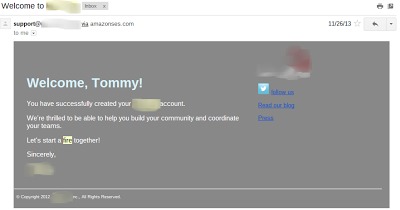
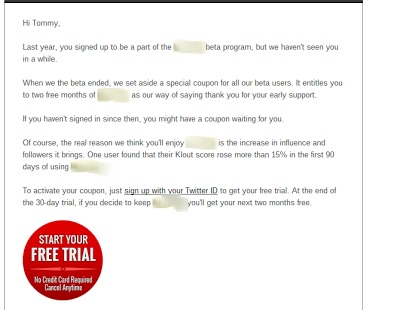

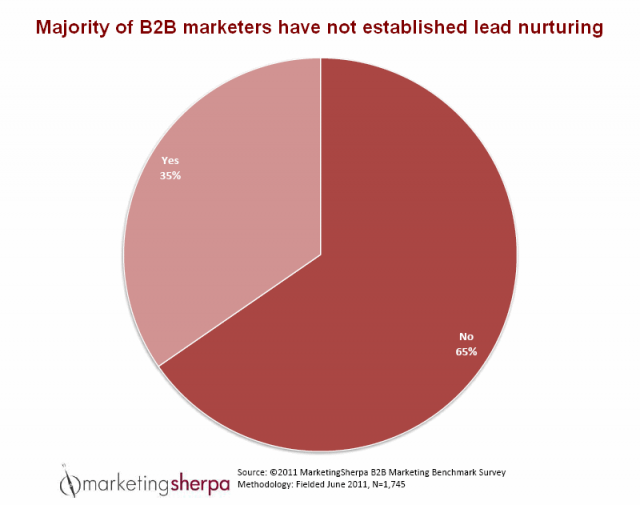




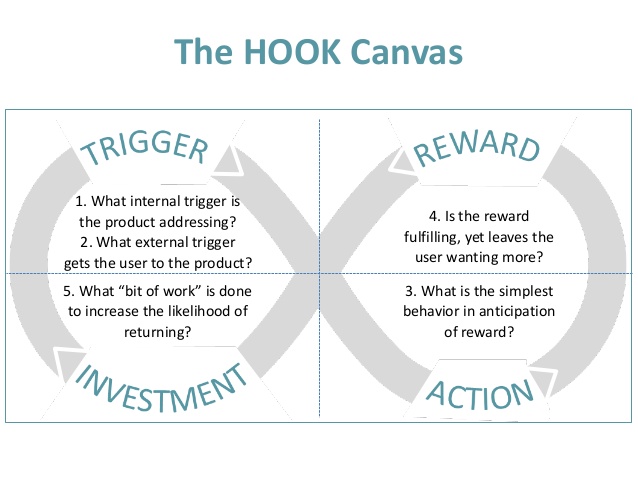
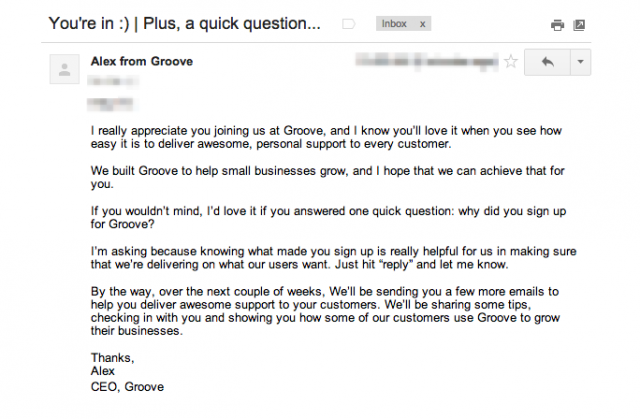
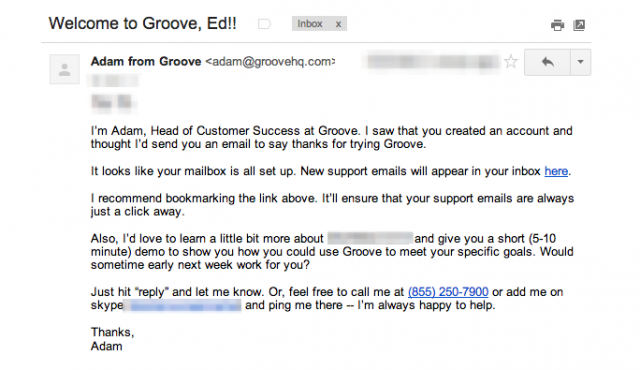
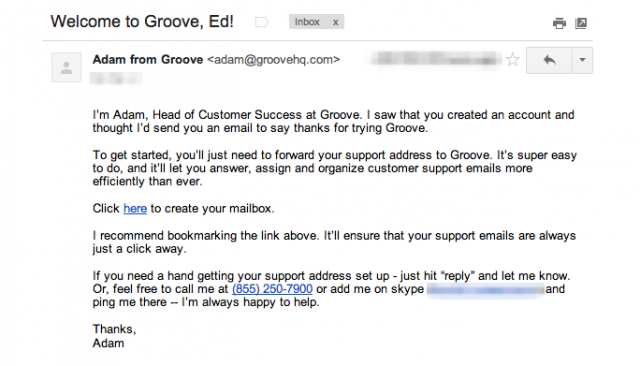
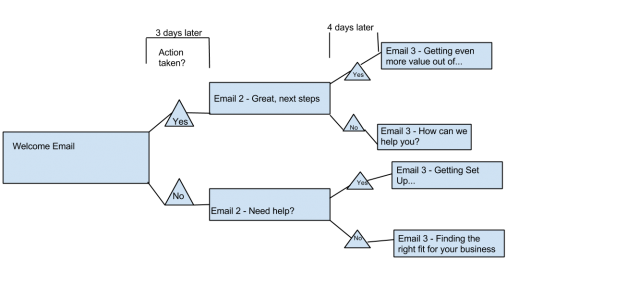
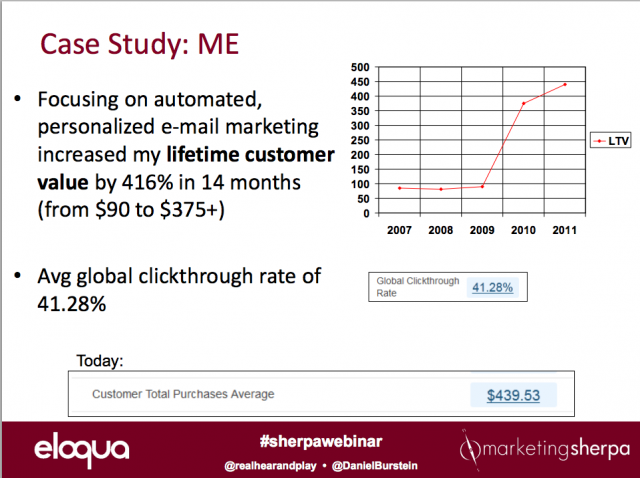


Wow, that’s a lot of great information. I have only a few clients that are using email effectively. With this information I can get a few more.
Thanks!!
I’m trying to sign up for your weekly tips but all I get is an error page :(
Great post Tommy, most companies are capable of conducting an onboarding series and tools like Hubspot are quite costly so I am glad you mention alternatives like Vero.
That was a big one when it came to all of this, there has to be some kind of alternative for the “little guy” right?
What you want to pay very close attention to though is the segmentation when using something like Vero. Because you’re losing the lead scoring capability, you HAVE to monitor the segments that are taking the most action.
However, if you nail that, you’re well on your way!
I agree with Randy, that really was a good post.
Please write a follow up to your target market post. People like myself struggle to define target markets in new industries that our clients bring to us. :)
Oooh. That will be fun! I’ve got a ton of tricks up my sleeve for that ;-)
I can’t wait.
If you look around, you’ll see there’s quite a few of us. :)
Wow. What an excellent post! I recently got hired as a sales and marketing assistant (the only one) at a small financial services firm (after getting a degree in political science), and all of this marketing stuff is brand new to me. I really appreciate how in depth your article was. It’ll definitely help me get a better handle on turning our new leads into customers, or at the very least, trying to sell my bosses on some changes I’d like to implement. Thank you!
Happy to help!
Tommy, the alternative for the little guy is Mailchimp. Now that they have triggers based on on-site activity (not just opens and clicks like before) you can set up some simple but effective flows.
And they do rudimentary scoring of leads based on email activity.
Very cool! Thanks for the heads up Hashim :-)
Hi hashim,
any link available?
cheers
Hi CK, this post from the MailChimp blog has a good overview of what Hashim was referring to: http://blog.mailchimp.com/new-trigger-emails-from-website-traffic/
Hey tyler,
cheers for the feedback and answers.
I am testdriving leadsius and jumplead. Mailchimp can do only 1 step after the goal is reached, you cant create like a 10 step drip email based on behaviour. What I really need is campaigns that trigger emails based on clicks, opens, and page visits/page behavior.
cheers! ;)
hey tommy, your blog posts kicks serious ass :)
Any other marketing automation companies out there? I know vero, but isnt there like a low budget marketing automation tool? Like hubspot but then without all the extra’s? And btw, infusionsoft does NOT track website behavior, they only track open/ click rates. SO you cant create a follow up based on website behavior..
cheers
Hey CK, a few worth checking out are Leadsius (free for up to 2,500 contacts), Spokal ($39/month), Jumplead ($40/month) and Drip ($49/month).
Thanks Tyler :-)
tyler dude! you made my day! cheers
Tyler,
Would Zoho CRM and their Zoho Campaigns work well in conjunction to achieve this in your opinion?
I’m surprised you didn’t mention Ontraport (formerly Office Autopilot) as an email marketing and CRM solution.
I used Infusionsoft for one year before switching over to Ontraport, and I singularly blame Infusionsoft for the copious amount of hair I lost that year. Infusionsoft is confusing as hell to use, and (in my experience) have an approach to customer service that borders on passive-aggressive.
Ontraport, on the other hand, has all the features of Infusionsoft (e.g. tagging, segmentation, triggers based on behaviour), but Ontraport is MUCH easier to set up, and their customer support is wonderful.
There is also an opportunity to onboard within the tool itself, which was a little outside of the scope here.
When a sign-up occurs, I send them a one-click email verification link with the text “..to make sure we can get in-touch with you for important account issues or password recovery”. Once they click-through, I don’t just verify them, but I present them with 3 more questions that help customize their account AND in-turn simplify their usage of the tool by making some default choices.
For instance, they are asked whether they primarily SHIP or DELIVER their products, and the web app uses the proper wording when orders are created or reviewed to reduce confusion.
Combining email onboarding with online methods is a great handshake.
Hi Peep,
I really enjoyed reading this post and I have learnt a lot just by reading this post.
In the past (or up till today), my auto-responder messages are at most 7 days long and I stop communicating after that. I was afraid that my subscribers would think I am spamming their emails if I email them too often for too long a period.
Reading your post has made me realized that I was wrong. You have given me the motivation to create more content in my follow up emails and i will definitely try to keep in touch with my readers more often and encourage more interaction.
You mentioned the use of auto-responders like Infusionsoft, that allows us to send emails that are event triggers.Whilst I understand the merits of the software that you mentioned, the initial price to pay is something that sets me back.I am currently using Aweber. I don’t think it has the option to send event-triggered emails.
Anyway, great posts. Look forward to more posts from you.
Cheers,
Boon
Great post Tommy. The absolute best part of this email is the personal footnote. The message that you get across here is pivotal to any good marketing campaign, online or offline. Regardless of what tool you use, the experience has to be top notch. It comes down to amazing customer service and just caring 1000 percent about your customer.
It still amazes me though we still often see that focus isn’t making sure the customer has a phenomenal experience during and especially after the buy. It’s critical for repeat success. It’s absolutely mind blowing that you still remember this personal experience step by step after 10 years. Nice work here.
Spot on with this write-up, I actually think this site needs much more attention. I’ll probably be returning to
read through more, thanks for the info!
Tommy mate, how can I thank you for the huge effort you put into this post. Good luck!
The conclusion of your post sums it all up. Thanks for the inspiration!